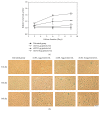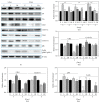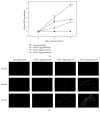Long-Term Treatment of Native LDL Induces Senescence of Cultured Human Endothelial Cells
- PMID: 28197300
- PMCID: PMC5288541
- DOI: 10.1155/2017/6487825
Long-Term Treatment of Native LDL Induces Senescence of Cultured Human Endothelial Cells
Erratum in
-
Erratum to "Long-Term Treatment of Native LDL Induces Senescence of Cultured Human Endothelial Cells".Oxid Med Cell Longev. 2017;2017:4576985. doi: 10.1155/2017/4576985. Epub 2017 Sep 20. Oxid Med Cell Longev. 2017. PMID: 29098060 Free PMC article.
Abstract
The study aimed to evaluate whether the treatment of primary cultured human endothelial cells with native low-density lipoprotein (nLDL) could induce their senescence and to uncover some of the putative mechanisms involved. For this purpose, human umbilical vein endothelial cells (HUVECs) were subcultured and/or continuously cultured with nLDL (0, 2, 5, and 10 μg protein/mL), for up to 9 days. The results indicated that nLDL inhibited the proliferation of HUVECs by arresting the cell cycle at G1 phase. The G1-arrested cells showed increase in cytosolic senescence-associated-β-galactosidase (SA-β-Gal) activity, a biomarker of cellular senescence. The causative factor of the cellular senescence was nLDL itself and not oxidized LDL (oxLDL), since blocking LDL receptor (LDLR) with the anti-LDLR antibody opposed the nLDL-induced increase of SA-β-Gal activity and decrease of cellular proliferation. In addition, nLDL-induced cellular senescence by inhibiting the phosphorylation of pRb (G1 arrest) via p53 as well as p16 signal transduction pathways. G1 phase arrest of the senescent cells was not overcome by nLDL removal from the culture medium. Moreover, the nLDL-treated cells produced reactive oxygen species (ROS) dose- and time-dependently. These results suggested, for the first time, that long-term treatment of nLDL could induce the premature senescence of endothelial cells.
Conflict of interest statement
The authors declare that there is no conflict of interests regarding the publication of this paper.
Figures






Similar articles
-
Native low density lipoprotein increases the production of both nitric oxide and reactive oxygen species in the human umbilical vein endothelial cells.Genes Genomics. 2019 Mar;41(3):373-379. doi: 10.1007/s13258-018-00777-4. Epub 2019 Jan 4. Genes Genomics. 2019. PMID: 30610621
-
Downregulation of B-myb promotes senescence via the ROS-mediated p53/p21 pathway, in vascular endothelial cells.Cell Prolif. 2017 Apr;50(2):e12319. doi: 10.1111/cpr.12319. Epub 2016 Nov 23. Cell Prolif. 2017. PMID: 27878894 Free PMC article.
-
An Inhibitor of Activated Blood Coagulation Factor X Shows Anti-Endothelial Senescence and Anti-Atherosclerotic Effects.J Vasc Res. 2019;56(4):181-190. doi: 10.1159/000499975. Epub 2019 Jul 2. J Vasc Res. 2019. PMID: 31266015
-
Cellular senescence and liver disease: Mechanisms and therapeutic strategies.Biomed Pharmacother. 2017 Dec;96:1527-1537. doi: 10.1016/j.biopha.2017.11.075. Epub 2017 Nov 22. Biomed Pharmacother. 2017. PMID: 29174037 Review.
-
[Senescence and cancer: double-dealing].Med Sci (Paris). 2018 Mar;34(3):223-230. doi: 10.1051/medsci/20183403010. Epub 2018 Mar 16. Med Sci (Paris). 2018. PMID: 29547108 Review. French.
Cited by
-
A Unified Model of Age-Related Cardiovascular Disease.Biology (Basel). 2022 Dec 6;11(12):1768. doi: 10.3390/biology11121768. Biology (Basel). 2022. PMID: 36552277 Free PMC article. Review.
-
Mechanisms and consequences of endothelial cell senescence.Nat Rev Cardiol. 2023 Jan;20(1):38-51. doi: 10.1038/s41569-022-00739-0. Epub 2022 Jul 19. Nat Rev Cardiol. 2023. PMID: 35853997 Free PMC article. Review.
-
Low density lipoprotein mimics insulin action on autophagy and glucose uptake in endothelial cells.Sci Rep. 2019 Feb 28;9(1):3020. doi: 10.1038/s41598-019-39559-7. Sci Rep. 2019. PMID: 30816192 Free PMC article.
-
LSEC model of aging.Aging (Albany NY). 2020 Jun 13;12(11):11152-11160. doi: 10.18632/aging.103492. Epub 2020 Jun 13. Aging (Albany NY). 2020. PMID: 32535553 Free PMC article.
-
Senescent Microvesicles: A Novel Advance in Molecular Mechanisms of Atherosclerotic Calcification.Int J Mol Sci. 2018 Jul 9;19(7):2003. doi: 10.3390/ijms19072003. Int J Mol Sci. 2018. PMID: 29987251 Free PMC article. Review.
References
-
- Celermajer D. S., Sorensen K. E., Spiegelhalter D. J., Georgakopoulos D., Robinson J., Deanfield J. E. Aging is associated with endothelial dysfunction in healthy men years before the age-related decline in women. Journal of the American College of Cardiology. 1994;24(2):471–476. doi: 10.1016/0735-1097(94)90305-0. - DOI - PubMed
-
- Eggen D. A., Solberg L. A. Variation of atherosclerosis with age. Laboratory Investigation. 1968;18(5):571–579. - PubMed
MeSH terms
Substances
LinkOut - more resources
Full Text Sources
Other Literature Sources
Research Materials
Miscellaneous

